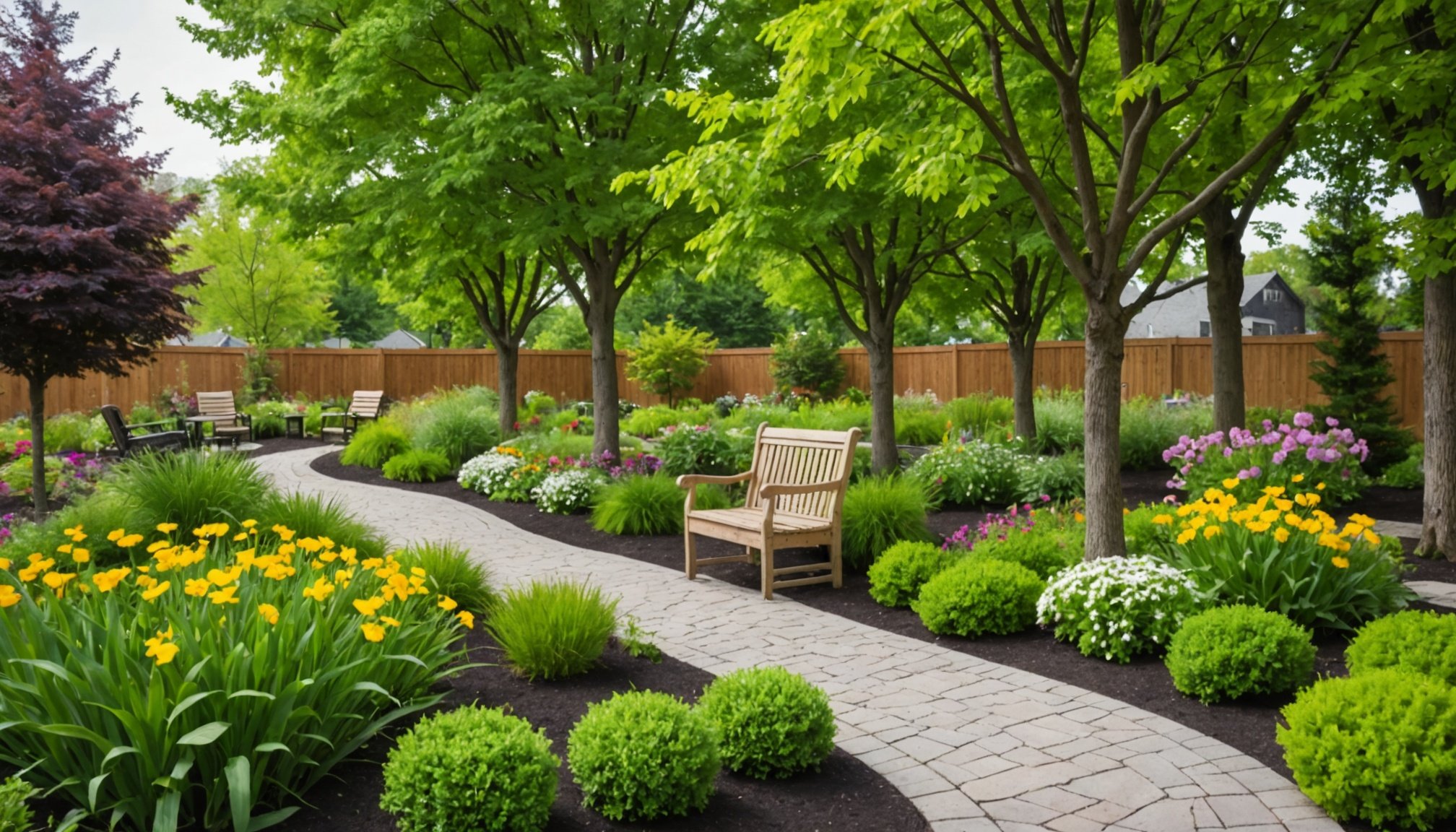Importance of Therapeutic Gardens for Seniors
Therapeutic gardens play a crucial role in promoting senior mental health by providing an environment where well-being through nature is enhanced. Studies have shown that engaging with nature can significantly improve both mental and physical health outcomes for older adults. Therapeutic gardens offer a serene and natural setting that encourages relaxation, reduces stress, and boosts overall mood.
Connection Between Nature and Health
For seniors, spending time in therapeutic gardens can foster a deep connection to nature, which is important for both mental and physical well-being. Nature therapy encourages sensory engagement, which can lead to improvements in cognitive function, emotional stability, and social interaction. The act of gardening or simply being around plants and flowers can bring a sense of peace and purpose.
Also to see : Effective stress relief strategies for seniors: boost your well-being and find peace
Evidence Supporting Therapeutic Gardens
Research has consistently indicated positive outcomes from incorporating therapeutic gardens into senior care settings. These gardens provide a safe space for physical activity, helping to alleviate mobility challenges and improve flexibility, strength, and balance. The gentle exertion involved in gardening also facilitates better cardiovascular health, complements rehabilitation efforts, and is an effective means of fostering social connections among seniors.
Therapeutic gardens are not just about plants; they’re about revitalizing lives.
In the same genre : Essential pain relief techniques for seniors: empowering chronic pain management strategies
Design Principles for Accessible Therapeutic Gardens
Creating accessible therapeutic gardens requires thoughtful design to ensure seniors can interact safely and comfortably with their environment. Key garden design principles focus on accessibility and addressing mobility challenges, enabling all seniors to experience the garden without barriers.
Key Elements of Garden Design
In designing accessible therapeutic gardens, consider how paths are laid out. Paths should be smooth, wide, and non-slip to accommodate wheelchairs and mobility aids. Integrating raised garden beds allows seniors to enjoy planting and tending without straining, as these can be accessed from a seated position. Handrails are crucial for added support, especially along sloped paths.
Understanding Space Requirements
Space planning is vital to ensure accessibility and comfort. Allocate enough room in accessible garden features for people to move and gather safely. Seating areas should be strategically placed, offering rest and social interaction opportunities.
Incorporating Sensory Features
Designs should incorporate sensory features that engage sight, smell, and touch. Elements like aromatic plants, textured surfaces, and gentle water features stimulate senses and provide therapeutic benefits. Sensory elements not only enhance well-being but also promote cognitive engagement, making the garden a place of healing and interaction for seniors.
Practical Features for Mobility Limitations
Designing therapeutic gardens to accommodate mobility challenges is essential for enabling seniors to engage safely and comfortably with nature. Accessible garden features like smooth, unobstructed pathways are vital, ensuring easy passage for wheelchairs and other mobility devices. These paths should have a non-slip surface to further enhance safety.
Raised garden beds are a noteworthy addition to any therapeutic garden. These beds bring plants to a comfortable height, allowing seniors to tend to them with minimal bending or physical strain. This design meets seniors at their skill level, transforming gardening from a daunting task to an enjoyable activity.
Integrating adaptive elements such as supportive handrails can significantly boost seniors’ confidence as they navigate garden spaces. These structures are not only physically supportive but also provide psychological reassurance. Seating options thoughtfully placed throughout the garden encourage moments of rest and social interaction, ensuring that seniors can enjoy the therapeutic setting fully at their own pace.
Psychological and Physical Benefits of Nature
Experiencing the psychological and physical benefits of therapeutic gardens can profoundly impact seniors. Nature therapy emerges as a pivotal contributor to mental wellness, often providing a sanctuary for reflection and emotional healing. This connection to nature can foster an emotional equilibrium, alleviating stress and contributing to a positive mindset.
From a physical perspective, engaging with gardening can enhance physical activity and mobility. Seniors benefit from gentle, regular exercise that helps maintain flexibility and strength. Activities like planting or watering can significantly boost cardiovascular health, promoting overall vitality.
Moreover, therapeutic gardens offer opportunities for cognitive engagement. Gardening activities stimulate the brain through sensory experiences, requiring attention, memory, and problem-solving skills. This connection with plants and nature encourages continuous learning and mental agility.
Additionally, the sensory features of gardening—touch, smell, and sight—can evoke memories and emotions, broadening cognitive engagement. Such elements not only nurture mental faculties but also promote a sense of accomplishment and purpose, essential for sustaining mental wellness. By integrating these various benefits, therapeutic gardens become an indispensable resource for enhancing the lives of seniors.
Recommended Plant Selections
Selecting plants for seniors involves choosing varieties that are both easy-care and enrich the sensory experience in therapeutic gardens. This task is crucial for ensuring that seniors engage with nature comfortably and effectively.
Low-Maintenance Plant Options
When considering plant selection, focus on low-maintenance plants such as succulents, lavender, and ornamental grasses. These types are resilient and require minimal watering, making them perfect for seniors, who may not have the stamina for extensive plant care.
Plants with Aromatic and Textural Qualities
Sensory plants stimulate engagement and bring a profound sense of satisfaction. Include options with captivating aromas and textures, like rosemary and lamb’s ear. These plants can aid memory recall and create a soothing sensory experience.
Edible Garden Opportunities
Introducing edible plants like basil, mint, or cherry tomatoes not only offers nutritional benefits but also enhances involvement in gardening activities. Such selections promote engagement while providing fresh, homegrown produce.
Choosing appropriate plants can transform therapeutic gardens into vibrant, interactive spaces tailored to seniors’ capabilities and preferences, making plant selection a pivotal aspect of garden design.
Safety Considerations in Garden Design
Safety in gardens is paramount, especially when designing spaces for seniors. A critical component is ensuring non-slip surfaces throughout pathways, which significantly aids in fall prevention. These surfaces are essential to prevent accidents, particularly in wet conditions.
In addition to pathways, regular maintenance plays a vital role in keeping garden spaces safe and accessible. Ensuring that debris, fallen leaves, or festering plant matter are cleared can reduce slip hazards and keep pathways clear.
Another strategy involves thoughtful layout planning to minimize hazards. Incorporating wide, accessible paths that accommodate wheelchairs or walkers can facilitate safe movement. Handrails along paths provide additional support, especially on inclines, offering confidence and stability to seniors.
Senior safety can be further enhanced by integrating proper lighting within garden areas. Well-lit spaces are essential for visibility, reducing the risk of tripping or stumbling, especially during dawn or dusk hours. This attention to safety makes therapeutic gardens more welcoming and secure for senior engagement.
Ultimately, a meticulous approach to safety not only promotes confidence but also augments the therapeutic nature of garden spaces, allowing seniors to navigate and enjoy their environment freely and with peace of mind.
Case Studies of Successful Therapeutic Gardens
Highlighting successful therapeutic gardens designed for seniors offers valuable insights into the positive effects these spaces can have. One standout example is the rooftop garden at Laguna Honda Hospital in San Francisco. This garden features accessible pathways, raised garden beds, and sensory plants, creating a nurturing environment for its residents. Users and caregivers report enhanced mood and increased interaction among seniors.
Similarly, at the Abbeyfield Society in the UK, the therapeutic garden design focuses on accessibility to mitigate mobility challenges. This garden includes handrails and wide paths to ensure safe navigation, especially crucial for seniors using mobility aids. The inclusion of seating areas invites rest and social interaction, enriching residents’ daily routines.
Another noteworthy example is the Elderwise garden in Seattle, which prioritizes sensory engagement. This garden utilizes aromatic and textural plants to encourage memory recall and interaction. Success in these gardens is reflected through improved mental health and the seniors’ ability to connect deeply with their surroundings.
Each of these gardens embodies thoughtful design principles that cater to the specific needs of seniors, demonstrating the profound impact a well-designed therapeutic garden can have on enhancing the well-being of older adults.
Community Resources and Expert Advice
Engaging seniors with therapeutic gardens goes beyond design and maintenance. Leveraging available gardening resources for seniors ensures they get the best out of these spaces. Many community initiatives offer programs tailored to senior gardening, advocating for physical activity and boosting mental wellness. Local community gardens often host workshops and events, providing a social framework that encourages participation and interaction with fellow enthusiasts.
Finding experts specialising in therapeutic garden design can transform ideas into workable solutions. Reaching out to professionals can provide tailored advice and innovative approaches, ensuring gardens are safe, accessible, and engaging. Such collaboration enhances garden efficacy, making them more beneficial for seniors.
For those seeking to delve deeper, numerous online resources offer extensive insights into gardening for seniors. Websites and literature can equip seniors and caregivers with the necessary knowledge to create, maintain, and enjoy therapeutic gardens. These sources allow continuous learning, ensuring seniors remain active and involved.
These resources collectively help in maximizing the benefits of therapeutic gardens, providing mental, physical, and emotional wellness for seniors and enriching their lives with nature’s touch.

